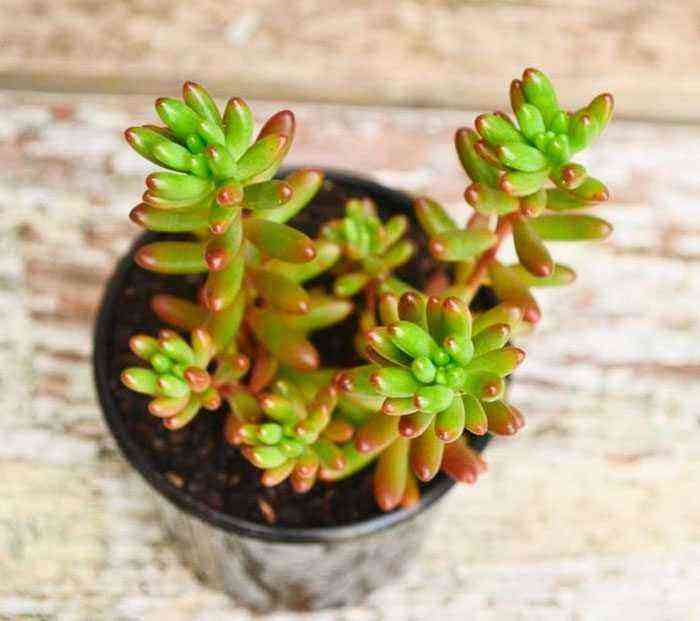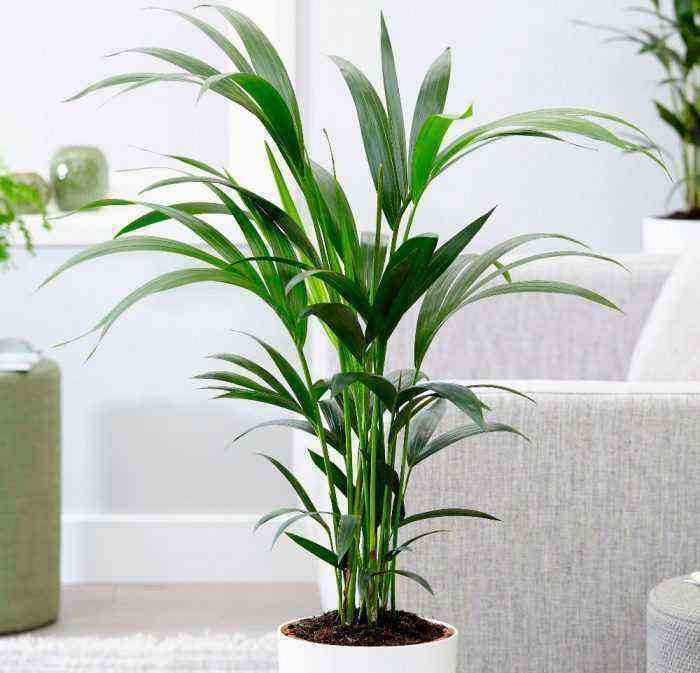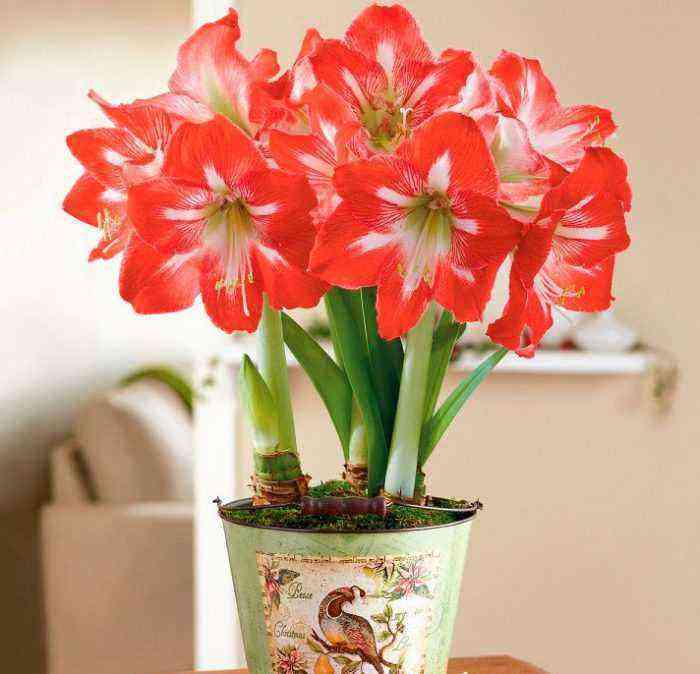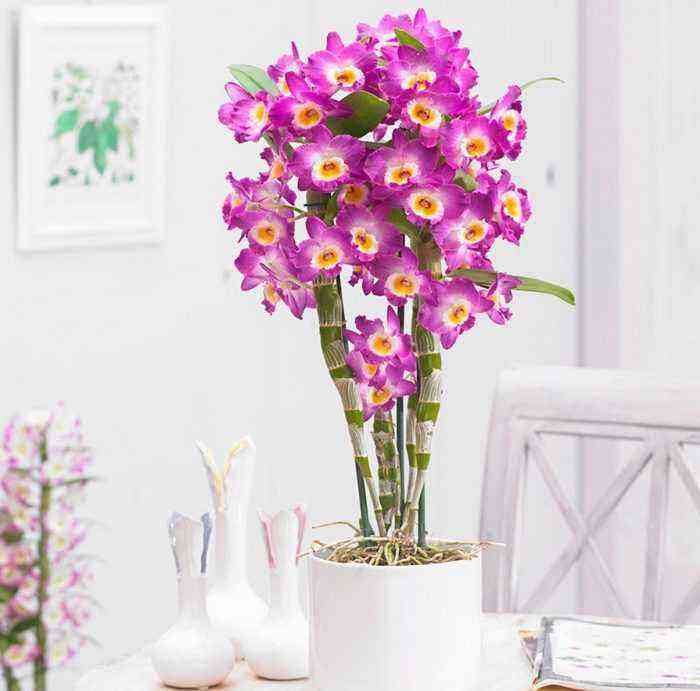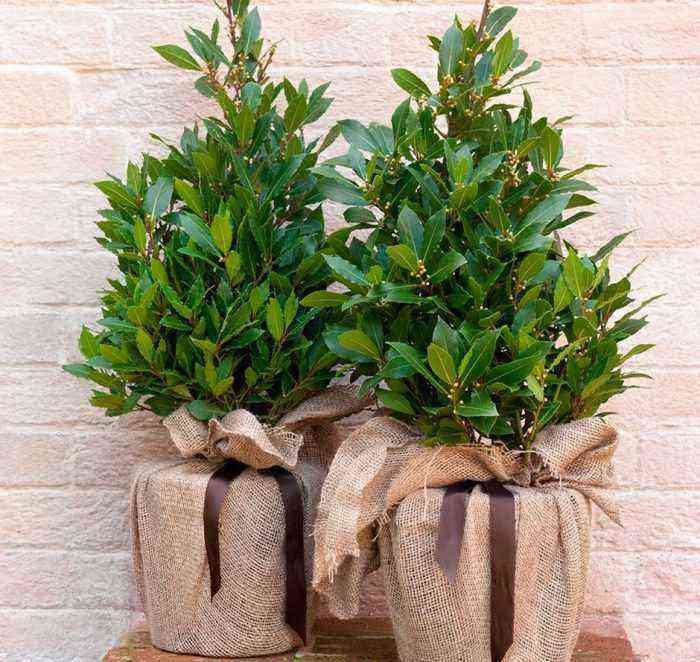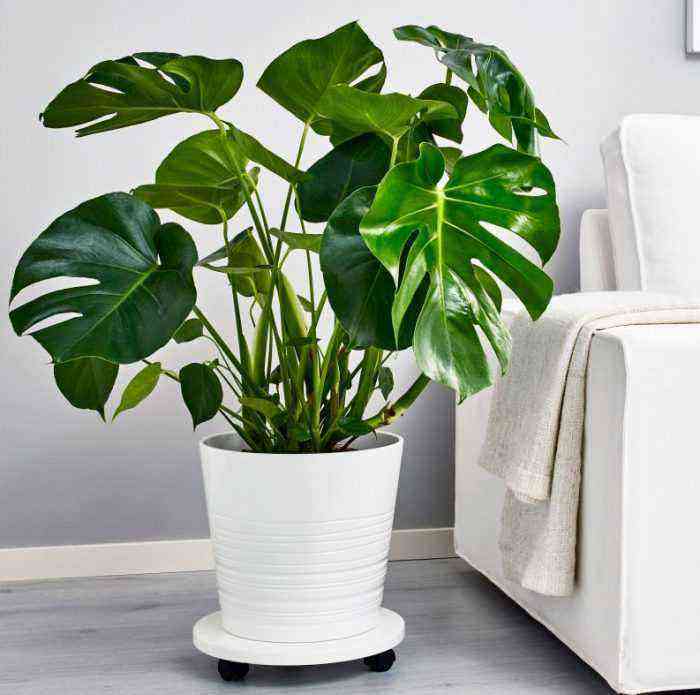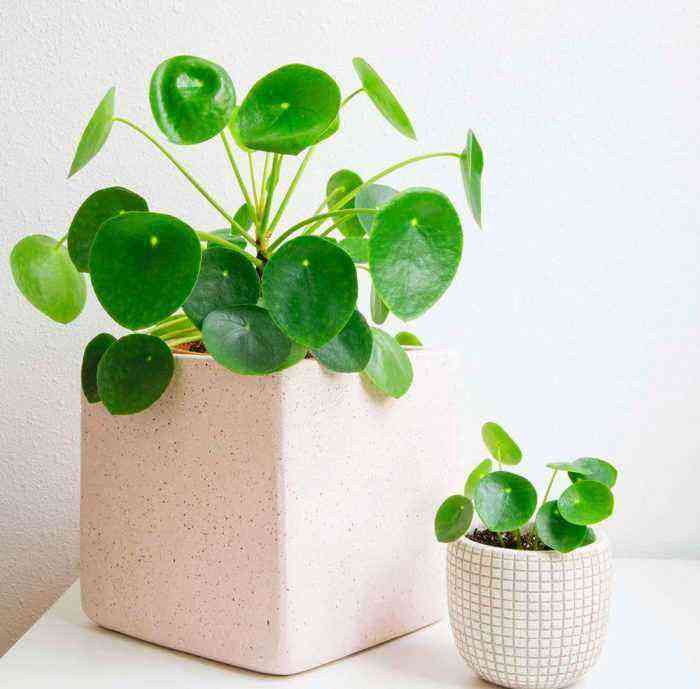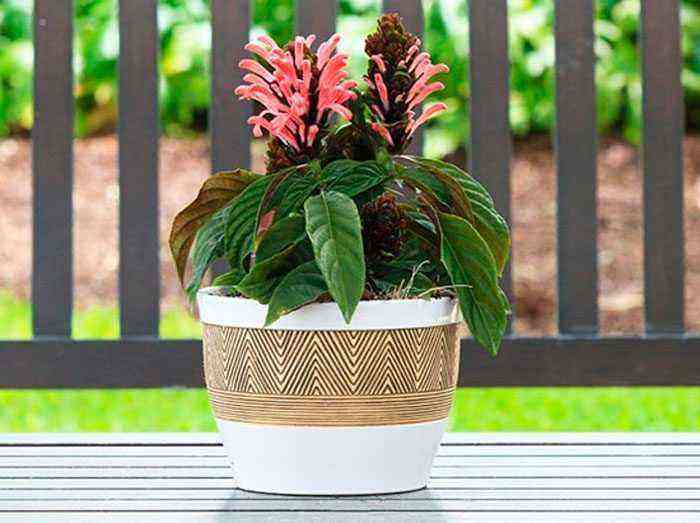The plant trachycarpus (Trachycarpus) is a member of the Palm family. The genus unites 9 species, in natural conditions they grow in the territory of East Asia. They are most widespread in China, the Himalayas, Japan and Burma. Such a palm tree is cultivated in all countries both in the open field and in indoor conditions. On the Black Sea coast of Crimea and the Caucasus, trachycarpus is the most common palm tree, since it is this plant that can withstand a drop in air temperature to minus 10 degrees for a long time.
Brief description of cultivation
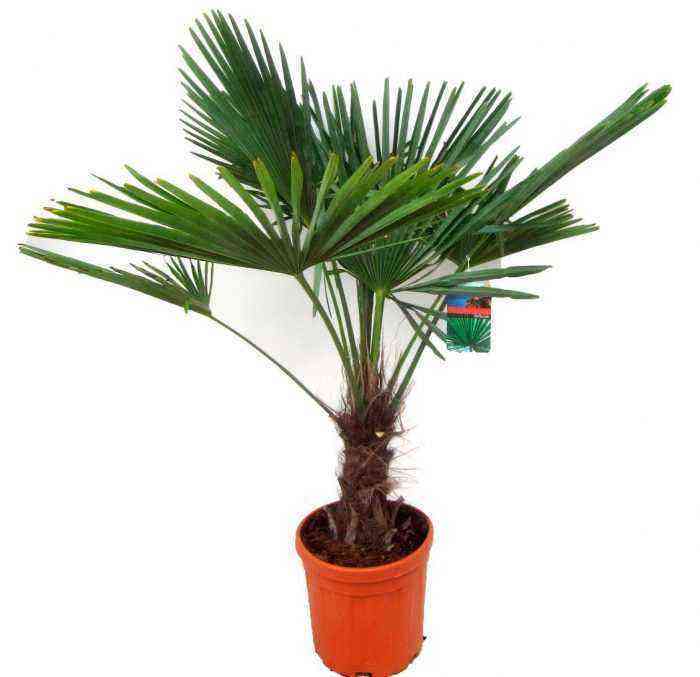

- Flowering… Trachycarpus is cultivated as an ornamental deciduous large-sized plant.
- Illumination… Grows well in small partial shade, as well as in bright, but diffused light.
- Temperature conditions… During intensive growth – from 18 to 25 degrees, and in the winter months – from 10 to 12 degrees.
- Watering… The soil mixture is moistened not very often and in moderation; they do this after it dries out to a depth of 20 to 30 mm.
- Air humidity… It should be elevated. It is recommended to wipe palm foliage with a damp soft cloth 1 time in half a month, however, it is highly undesirable to moisten it from a sprayer.
- Fertilizer… Top dressing is carried out in April – August with a frequency of 1 time in 20 days, for this use a solution of mineral complex fertilizer for palms at half the dosage recommended by the manufacturer. In winter, the palm is not fed.
- The rest period… It is not pronounced clearly, however, in the cold season, the plant grows and develops more slowly.
- Transfer… While trachycarpus is young, it is transplanted every year, and more mature plants – 1 time in 3 or 4 years. If the palm tree is old, then it is not necessary to replant it, but every year the top layer of the soil mixture in the container is replaced with a fresh one.
- Reproduction… By seed method, but more often by shoots.
- Harmful insects… Mealybugs, spider mites, scale insects, aphids and thrips.
- disease… Black and gray rot.
Features of trachycarpus
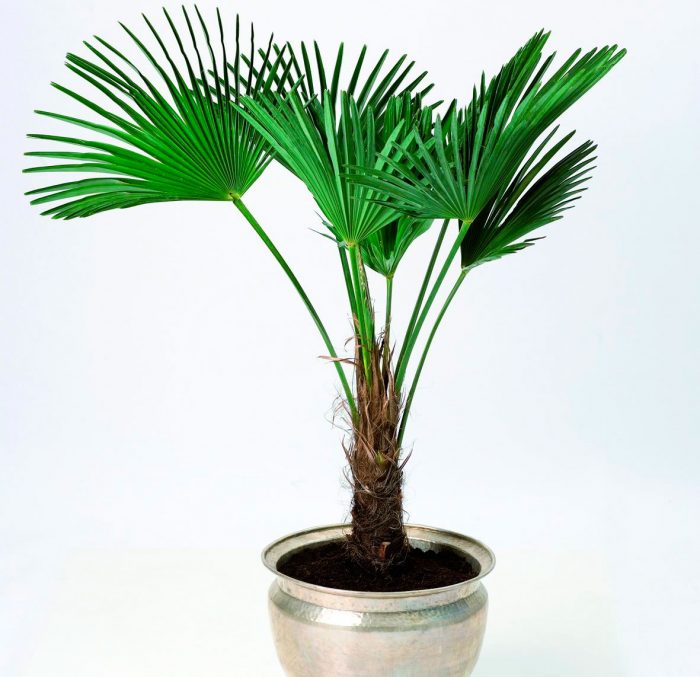

Under natural conditions, the straight trunk of the trachycarpus has a height of 12–20 m; its surface is covered with fibers of dead leaf plates. When grown at home, its height does not exceed 2,5 meters. Oblong-rounded leaf plates, reaching about 0,6 m in diameter, have long, often spinous petioles. The leaves are divided into segments, while in some species the separation occurs to the base, while in the other part the foliage is divided only to half of the plate. On the seamy surface of the foliage there is a bloom of a pale bluish color. During flowering, a racemose inflorescence is formed, consisting of fragrant yellow flowers, but it should be noted that indoor trachycarpus does not bloom. In a palm tree growing in a greenhouse or in a garden, at the end of flowering, clusters of bluish-black fruits are formed in place of flowers, which outwardly resemble a small grape.
Caring for trachycarpus at home
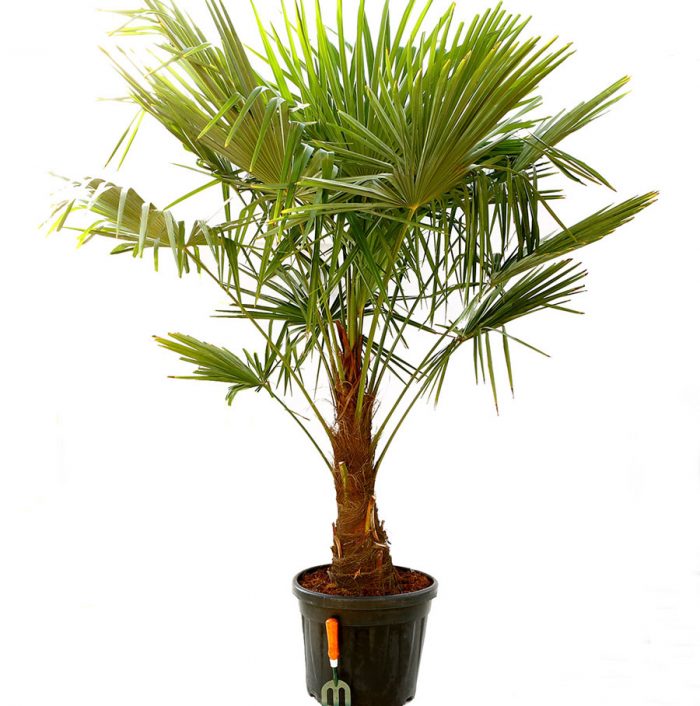

Trachycarpus grown in indoor conditions is distinguished by its undemanding care and unpretentiousness. If you create optimal conditions for growth for him, then there should be no problems with him.
Illumination
Such a fan palm belongs to light-loving plants, but it can be grown in any light level. If a place is chosen for it near a south-facing window, then in the summer you will need to shade it from the direct scorching rays of the sun, and also systematically ventilate the room. Remember that a draft can severely damage the trachycarpus. In order for the bush to grow and develop symmetrically, it must be rotated 1 degrees around its axis once every half a month. In the summer, the plant can be transferred to the street, however, it is recommended to accustom it to new conditions gradually.
Temperature conditions
During the warmer months, the palm tree grows best at temperatures between 18 and 25 degrees. She does not like high air temperatures. In the heat, its growth stops, and the tips of the leaf plates become brown, which negatively affects the decorative effect of the bush. In winter, it is recommended that the palm rest at a temperature of 10 to 12 degrees, but it also tolerates a warm winter well.
Trimming
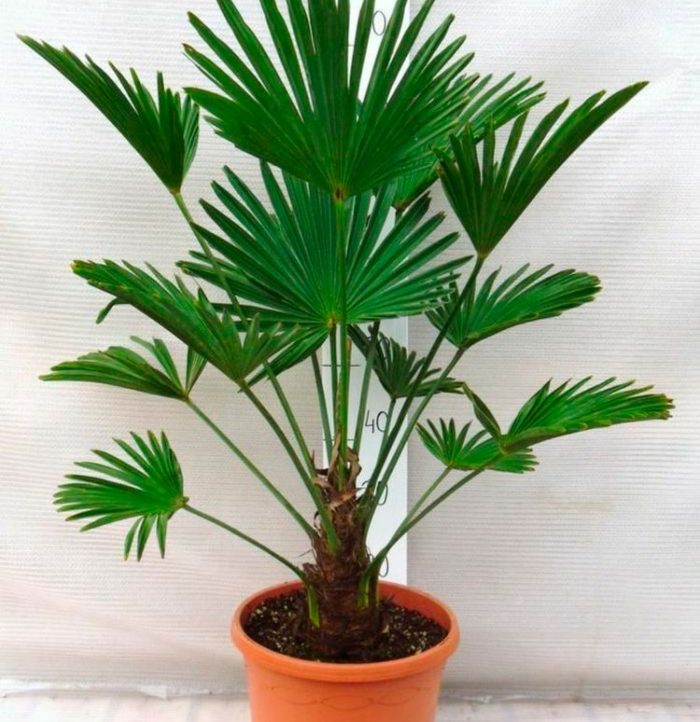

In order for a palm tree to always look neat and effective, it needs to regularly cut off injured, dead or overly drooping leaf plates. During the year, you can cut as many leaves as the bush can reproduce. It is not recommended to cut off leaf plates that have begun to turn yellow, as they still feed the palm tree. Also, you should not cut off those leaves that have become brownish ahead of time. All lateral shoots that appear are recommended to be cut off, they are left only if they want to propagate trachycarpus in a vegetative way.
Watering and humidity
The palm tree is highly drought tolerant, so it is rarely and moderately watered. With frequent or abundant watering, rot can develop on the roots. Moistening of the substrate in the pot is carried out only after it dries out to a depth of 20-30 mm. For watering, they take filtered or well-settled water, since the plant reacts negatively to chlorine.
In summer, once every 1 weeks, it is recommended to arrange a warm shower for the palm tree, while the surface of the soil mixture in the container must be protected from water ingress with a film. In the cold season, periodically wipe the foliage with a soft cloth dampened in clean water. It is not recommended to moisten foliage from a spray bottle either in summer or in winter. To increase the level of humidity, you can place several open containers filled with water next to the bush, or you can use a special household humidifier. Spots and dust from the foliage are removed with a piece of flannel, which is moistened in a solution of oxalic acid (2%). Then it is washed under a warm shower and wiped dry. It is impossible to polish the leaves with special chemicals.
Fertilizer
For feeding, a solution of mineral complex fertilizer for palms is used, which is enriched with microelements. Top dressing is carried out during intensive growth (from April to August) once every 1 days, while using half the dosage recommended by the manufacturer.
Tracicarpus transplant
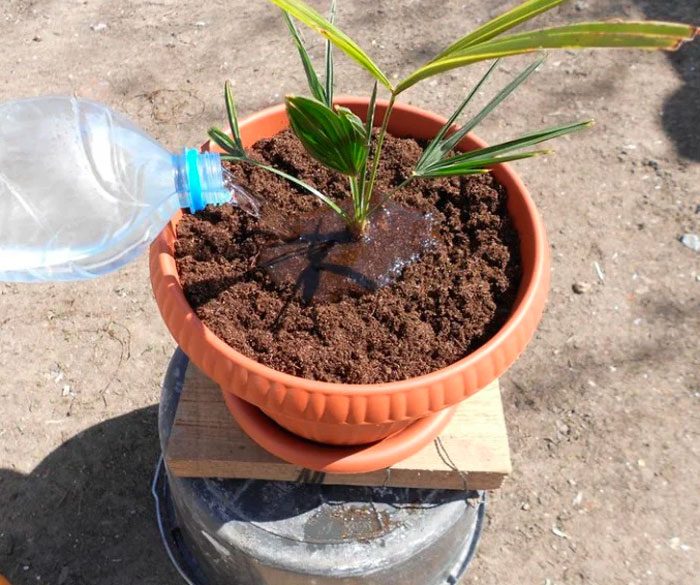

A flower is transplanted only when there is a need for it, or rather, when the roots in the pot become cramped, and they appear from the drainage holes. As a rule, young bushes need a regular transplant, which is carried out once a year, and adult specimens are carefully transferred into a new pot once every 1 or 1 years. Old large palms can be badly damaged during transplantation, so this procedure is prohibited for them, but every year in spring they replace the top layer of soil mixture with a thickness of about 3 mm with a fresh one. Since the roots of the plant are very sensitive, the bush is transplanted by transshipment, while trying to preserve as much soil mixture as possible on the root system. The earthen mixture is used with loose, well-permeable water with a pH of 4–50. Water must pass through the substrate very quickly (in just a few seconds). The best soil mixture for this palm is one that consists of humus, compost and sod soil, as well as perlite or coarse sand (5,6: 7,5: 1: 1). For its cultivation, you can also use a substrate consisting of moist peat, sod and leafy soil, as well as sand or perlite (1: 1: 2: 2). If desired, you can purchase ready-made soil mixture for palm trees in a specialized store.
A couple of weeks before transplanting, any of the soil mixtures must be disinfected, for this it is spilled with a strong solution of potassium permanganate or ignited in the oven, and a microwave is also suitable for this. Lay a good and rather thick layer of drainage on the bottom of the new container, after which the plant, taken together with a lump of earth, is carefully placed in it, then all existing voids are covered with fresh earth mixture. After transplanting, check that the lower part of the trunk of the bush is at the same level as in the old pot; in no case should it be buried. The transplanted plant is well watered and removed to a shaded place where it will stay for several days. There is no need to feed this plant for 4–6 weeks, at this time it will have enough of those nutrients that are contained in the fresh soil mixture.
Methods of reproduction
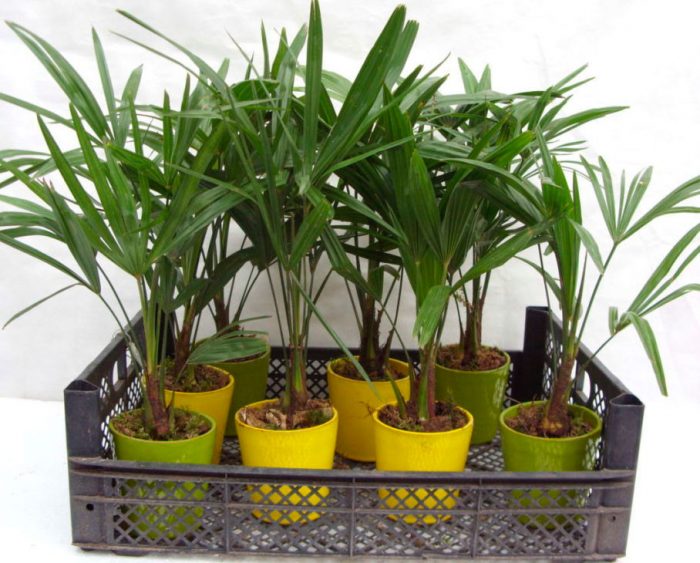

Cultivation from seeds
The seed propagation method of trachycarpus is not very popular among flower growers, because it is very complicated and time-consuming. And the seed material of such a palm tree remains viable for only 1 year. If you managed to find fresh trachycarpus seeds, then sow them in January-February immediately in separate cups filled with seedling soil mixture, cover them with a film (glass) on top. The first seedlings should appear after 1-2 months. In order for them to grow and develop normally, they are placed in a well-lit (light should be diffused) place where the air temperature is constantly kept at a level of 20 to 22 degrees. Water them in moderation. If everything is done correctly, then by the end of the first year of growth, up to 5 leaf plates can form in young plants. The foliage will begin to divide into segments during the 5–7 plate formation stage.
Reproduction by shoots
This method is much more often used by flower growers, as it is more reliable and faster. In each of the palms belonging to this genus, in conditions of high humidity, the formation of a basal process is observed. If the humidity is low, then the scion will not grow. After the outgrowth reaches about 70 mm in diameter, it is cut from the parent bush at the point of narrowing, using a very sharp pre-sterilized tool. Then all the foliage is removed from it. The cut site is treated with a solution of a fungicidal preparation and an agent that stimulates root growth. For rooting, it is planted in a mixture consisting of perlite and coarse sand (1: 1). In order for the roots to appear as soon as possible, the shoot is placed in a shaded place where the air temperature does not drop below 27 degrees, while making sure that the substrate is slightly damp all the time. As a rule, after 6–12 months, with proper care, a good root system is formed at the scion. The rooted plant is transplanted into a pot filled with potting soil for adult palms (see above).
Diseases and pests
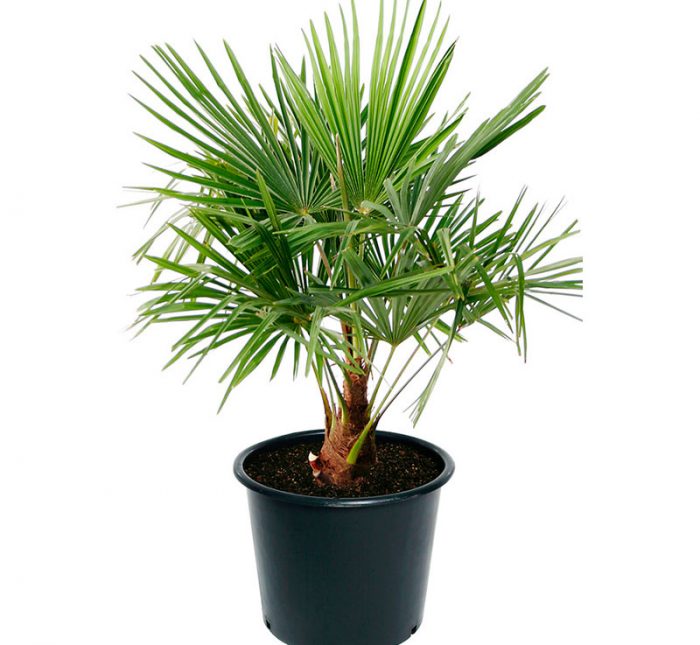

Diseases
Due to too frequent and abundant watering, black or gray rot may develop on the trachycarpus. Also, sometimes its foliage turns yellow or brown specks form on its surface. If the plant is struck by a fungal disease, then it can be cured with a fungicide solution. However, many growers believe that it is much easier to provide a palm tree with the correct watering regime than to try to heal it later.
The plant can also suffer if it is placed in the darkest corner, as well as exposed to a draft or direct sunlight on a hot summer day. If there are very few nutrients in the soil mixture, then this will cause the appearance of yellow foliage, as well as slow growth of the bush. Also, the foliage turns yellow if the room is too hot or when the bush is watered with hard water. If the lump of earth in the pot dries up completely, then the growth of the trachycarpus will stop, and all the leaves will die off. However, if you provide the plant with good care, then there should be no problems with it.
Harmful insects
Lush large foliage of palm trees is a kind of “delicacy” for sucking harmful insects. So, scale insects, thrips, mealybugs, aphids or spider mites can settle on the bush. All of them bite through the foliage and suck the juice out of it. To get rid of uninvited guests, purchase a special product in the store designed to destroy arachnids or insects that live on indoor flowers. For example, you can buy such effective insectoacaricidal agents as: Akarin, Aktellik, Fitoverm, etc. It is recommended to treat the plant with chemicals on the street, as they can harm not only insects, but also humans. If scale insects or mealybugs have settled on the bush, then before processing they are removed from the foliage by hand.
Types and varieties of trachycarpus
In indoor conditions, several types of trachycarpus are cultivated by flower growers. The most popular ones will be described below.
Trachcarpus Fortune (Trachycarpus fortunei)
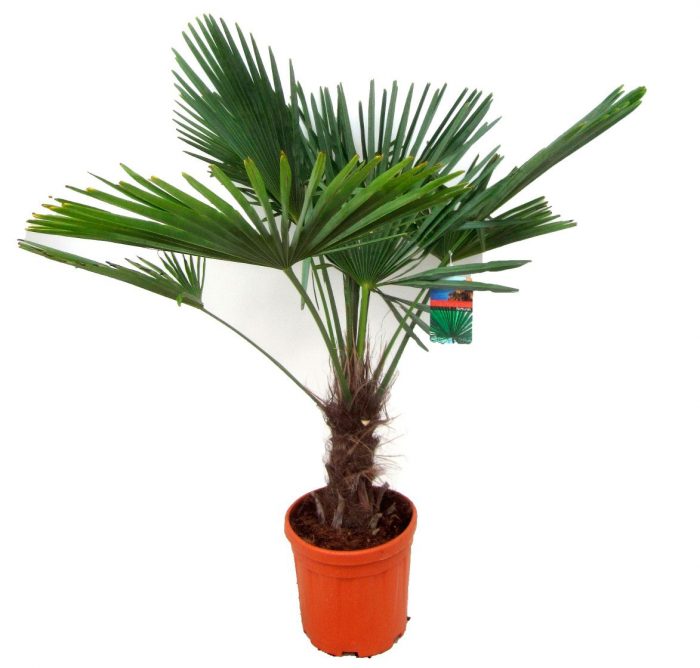

This is the most famous species of this genus, which in natural conditions can reach a height of about 12 meters. When growing a house, its height, as a rule, does not exceed 250 cm. The surface of the trunk is covered with a rough fur coat, which consists of the remains of petioles, dead leaf plates. The leaves are deeply divided into a large number of segments, their front surface is dark green, and on the back there is a silvery bloom. During flowering, racemose inflorescences appear, which include fragrant yellow flowers. But in indoor conditions, the palm tree does not bloom.
Trachikarpus two-segment
This type is most popular with flower growers. In height, the plant can reach up to 250 centimeters, and in diameter – from 20 to 25 centimeters. In the upper part of the trunk, the surface of which is covered with stalks of dead foliage, there are from 12 to 15 large fan-shaped leaf plates, which are dissected to the very base.
Trachycarpus Wagner (Trachycarpus fortunei Wagnerianus)


In Russia, this species is not very popular with flower growers, but in China, Japan and Korea it is grown quite often. Under natural conditions, such a plant can reach a height of about 7 meters, it is decorated with dark green dense leaf plates, located on rigid petioles. The palm tree is highly resistant to gusts of wind and cold.
Trachycarpus martiana
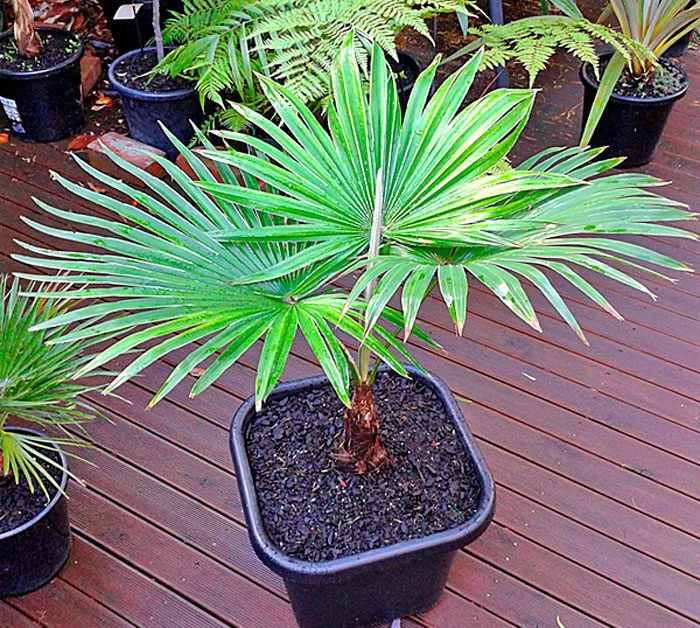

In such a thermophilic palm, the trunk is practically bare. The dense foliage is dissected into many segments (60 to 70). In areas with a warm and mild climate, this species is cultivated in the garden.
Trachycarpus high (Trachycarpus excelsa)
This species differs from the rest in that it is the most resistant to frost. It is widely cultivated in many countries. The lower part of the wide trunk is covered with scales, and the tough foliage has a bluish bloom. In nature, the height of a palm tree can reach up to 16 meters, and when grown indoors – up to 3 meters.
Dwarf trachycarpus (Trachycarpus nanus)
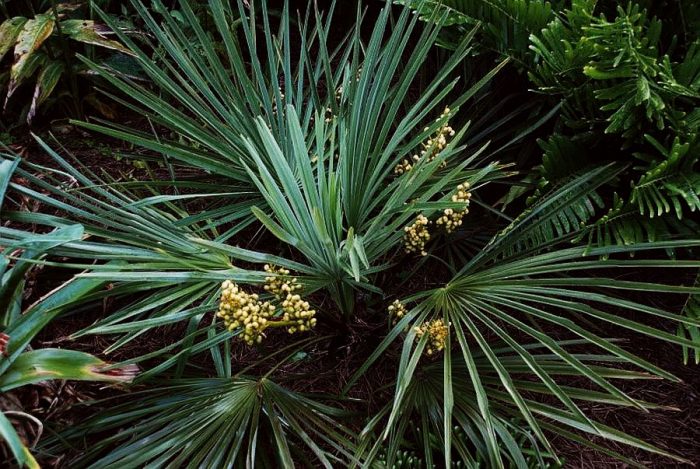

This variety is quite interesting. Its root system is able to penetrate into the deep layers of the soil, but the height of the plant is only about half a meter. There is a bluish bloom on the surface of the fan-shaped round leaf plates.
